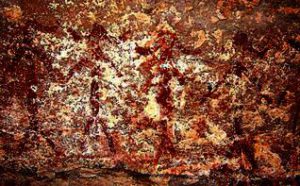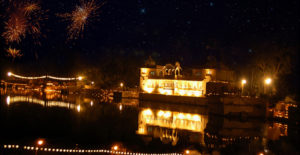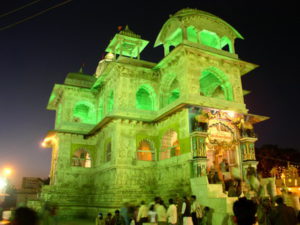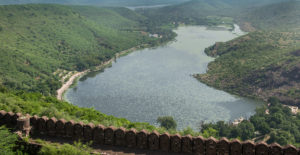Location, Area & Administration of Bundi:
Bundi is located in a narrow gorge surrounded on three sides by hills of the Aravalli Range and is located at 25.44°N 75.64°E and an average elevation of 268 meters. The district of Bundi is bordered by Tonk in north direction, Sawai-Madhopur in north-east, Kota in east, Chittorgarh in south, and Bhilwara in west.
Bundi district has 5850 Sq. Km, which is divided into 6 Tehsils namely Bundi,Indragarh,Hindoli, Keshavraipatan, Nainwa and Taleda.
History of Bundi:
In ancient times, the area around Bundi was inhabited by various local tribes majority group belonging to Meena. Bundi is said to derive its name from a former Meena tribe chief called Bunda Meena. Bundi was previously called “Bunda-Ka-Nal”, Nal meaning “narrow ways”. Later the region was acquired by Rao Deva Hada, who took over Bundi from Jaita Meena in 1342, and established a princely state Bundi, renaming the surrounding area called Hadoti, the land of great Hada Rajputs.
Rulers of Bundi
- Rao Deva Hada (1342-43)
- Laid the foundation of hada state of Bundi after taking possession from Jaita Meena.
- Rao Napuji (1343-84)
- Rao Hamuli (1384 – 1400).
- Rao Birsingh (1400 to 1415).
- Rao Biru (1415 to 1470).
- Rao Bandu (1470 to 1491).
- Rao Narayan Das (1491 to 1527).
- Rao Suraj Mal (1527 to 1531).
- Rao Surtan Singh (1531 to 1544).
- Rao Raja Surjan Singh (1544 to 1585)
- Akbar & Man Singh I – negotiate treaty with Surjan Singh – hence given title of “Rao Raja”
- Given government of Benares.
- Rao Raja Bhoj Singh (1585 to 1608)
- Rao Raja Ratan Singh (1608 to 1632)
- Ratan Singh & his son Madho Singh – fight war against rebels & win during jehangir reign.
- Jehangir divides Hadoti to Bundi & kota, giving Kota as separate state to madho Singh
- Shah Jehan confirmed grant of Kota to Madho Singh.
- Rao Raja Chhattar Sal Singh (1632 to 1658)
- Chhatar Singh is made governor of Delhi by Prince Dara Shikoh (the son of Moghul Emperor Shah Jahan), but he dies fighting against Shah Jahan’s successor, Aurangzeb.
- Rao Raja Bhao Singh (1658 to1682)
- Fights Aurangzeb and win against Raja Atmaram. Aurangzeb impressed and reconciles with Rajao Bhao making him governor of Aurangabad.
- Rao Raja Anirudh Singh (1682 to 1696)
- Rao Raja Budh Singh (1696 to 1735)
- On Aurangzeb death Budh Singh ji supports Bahadoor Shah Alam, wheras Ram Singh of Kota sides with Prince Azim> Hence, rivalry between Bundi & Kota develops.
- Rao Raja Dalel Singh (1735 to 1749).
- Rao Raja Umaid Singh (1749 to 1770) – (1773 -1804).
- Rao Raja Ajit Singh (1770-1773).
- Rao Raja Bishen Singh (1804-1821).
- Maharao Raja Ram Singh Sahib Bahadur (1821-1889)
- Colonel HH Maharao Raja Shri Sir Raghubir Singh Sahib Bahadur (1889-1927)
- Supported Britain in WWI
- Major HH Maharao Raja Shri Sir Iishwari Singh Bahadur (1927-1945).
- HH Maharao Raja Shri Bahadur Singh Bahadur (1945-77)
Historical Places of Bundi:
Taragarh Fort:
 Taragarh Fort was constructed by Rao raja Bair Singh in 1354 on a hilltop 1426 feet high. In the centre of the fort is located Bhim Bhurj on which was once mounted a particularly large cannon called Garbh Gunjam, or ‘Thunder from the Womb’. With its curved roofs topping pavilions, excess of temple columns and elephant and lotus motifs, the palace is a tribute to Rajput style. The fort includes Hazari Darwaza, Haathi Pol, Nau Dhaan, Ratan Daulatkhana, Darikhana, Ratan Niawas, Chatra mahal, Badal Mahal & Moti Mahal.
Taragarh Fort was constructed by Rao raja Bair Singh in 1354 on a hilltop 1426 feet high. In the centre of the fort is located Bhim Bhurj on which was once mounted a particularly large cannon called Garbh Gunjam, or ‘Thunder from the Womb’. With its curved roofs topping pavilions, excess of temple columns and elephant and lotus motifs, the palace is a tribute to Rajput style. The fort includes Hazari Darwaza, Haathi Pol, Nau Dhaan, Ratan Daulatkhana, Darikhana, Ratan Niawas, Chatra mahal, Badal Mahal & Moti Mahal.
Sukh Mahal
Sukh Mahal, a small, two-storied palace was a summer retreat of past rulers. Located on banks of JaitSagar lake, the palace was constructed by Rao raja Vishnu Singh in 1773 A.D. Today, it is quite famous for being the place where Kipling wrote ‘Kim’. Many credit the palace as a having played muse to the renowned novel. In fact, part of a movie based on the novel was even shot here.
Rani ji Baori
 Bundi has more than 50 stepwells and rightly known as city of stepwalls . Raniji ki Baori, also known as ‘Queen’s Stepwell’, is a famous stepwell built in 1699 by Rani Nathavati Ji, the younger queen of the ruling king Rao Raja Anirudh Singh of Bundi. This multi-storied stepwell displays excellent carvings of Gajraj with his trunk turned inwards, giving the impression of having drunk from the baori on its pillars. Its high arched gate gives it an inviting appearance.
Bundi has more than 50 stepwells and rightly known as city of stepwalls . Raniji ki Baori, also known as ‘Queen’s Stepwell’, is a famous stepwell built in 1699 by Rani Nathavati Ji, the younger queen of the ruling king Rao Raja Anirudh Singh of Bundi. This multi-storied stepwell displays excellent carvings of Gajraj with his trunk turned inwards, giving the impression of having drunk from the baori on its pillars. Its high arched gate gives it an inviting appearance.
84 Pillared Cenotaph or चौरासी खंभों की छतरी
 As the name suggests, the 84 Pillared Cenotaph is a structure supported by 84 columns. Commissioned by Rao Anirudh, the Maharaja of Bundi, this cenotaph is a tribute to his beloved wet nurse, Deva, who he loved dearly. A popular tourist attraction, this impressive structure is decorated with carvings of deer, elephants and apsaras.
As the name suggests, the 84 Pillared Cenotaph is a structure supported by 84 columns. Commissioned by Rao Anirudh, the Maharaja of Bundi, this cenotaph is a tribute to his beloved wet nurse, Deva, who he loved dearly. A popular tourist attraction, this impressive structure is decorated with carvings of deer, elephants and apsaras.
Gadra Cave Paintings:
 In 2010, Bundi-based archaeologist Om Prakash Sharma alias Kukki discovered 32 sites in the rock painting stretching over the basin of Mangli river. The rock paintings are about 10,000-year-old and belong to Mesolithic-Chalcolithic period.
In 2010, Bundi-based archaeologist Om Prakash Sharma alias Kukki discovered 32 sites in the rock painting stretching over the basin of Mangli river. The rock paintings are about 10,000-year-old and belong to Mesolithic-Chalcolithic period.
Fairs & Festivals of Bundi:
Kajali Teej Mela
 The Teej Festival is celebrated throughout the rainy season in Rajasthan, with each region having its own take on celebrations.It is is celebrated in Bundi on the third day of Bhadra Pad whereas it is takes place on the third day of Shravana at other places in the state. The fest is particularly vibrant with the traditional procession of the goddess in a decorated palanquin which passes through the main bazaar and the streets.
The Teej Festival is celebrated throughout the rainy season in Rajasthan, with each region having its own take on celebrations.It is is celebrated in Bundi on the third day of Bhadra Pad whereas it is takes place on the third day of Shravana at other places in the state. The fest is particularly vibrant with the traditional procession of the goddess in a decorated palanquin which passes through the main bazaar and the streets.
The Gangaur Festival
Gangaur festival is one of the major festivals in Bundi and is celebrated with great devotion by women who are the devotees of goddess Gauri. It marks the celebration of harvest, spring and marital fidelity. Women celebrate this festival for long and prosperous lives of their husbands.
Bundi Festival
Bundi festival was started by Rajmata Sahiba Daulat Kanwar Of Dugari & Shri Madhukarji Gupta which was inaugurated by Shreeji Arvind Singh Mewar & Kunwar Shivam Singh Dugari in 1998.he Keshorai Patan town is embellished during this festival just like Pushkar. The festival is promoted by Rajasthan tourism & district administration of Bundi and will be organized on November 17-19 in 2016.
Fair at Keshavraipatan:
Keshavraipatan is a town located in Bundi districts on banks of chambal river. Here, a fair is organized in November month on Kartik purnima, where more than 1 lakh devotees assemble and take bath in Chambal river.
Dargah of Makkeshah is also a revered place located in same area.
Geography of Bundi:
Physiographically Bundi district is irregular rhombus shaped, traversed throughout its whole length from south-west to north-east by a double line of hills constituting the central Bundi range, which divides it in about two equal portions. For many miles the precepitous scarp on southern face of this range forms an almost impassable barrier between the plain country on either side. The main rivers crossing the district are Chambal and Mez. Smaller rivers include Mangli, Eais, Talera and Ghora Pachar.
Natural Places of Bundi:
Ramgarh Vishdhari Sanctuary:
Ramgarh Vishdhari sanctuary has an area of 307 Square kms and is situated within hills of Bundi range.Established in 1982, it forms a buffer for Ranthambore National Park. The variety of fauna found in sanctuary include Panther, hyena, Sloth Bear, jackal, Fox, Chital.
Jait Sagar Lake, Bundi

Located close to the Taragarh Fort, this picturesque lake is surrounded by hills and covered with pretty lotus flowers that bloom during winter and monsoon.
Kanak Sagar Lake, Bundi
About 67 kilometres from the town of Bundi lies this wonderful flat lake. There is also a town named after the lake. One can spot several migratory birds here such as bar headed goose and Demoille cranes all through the year.
Nawal Sagar lake, Bundi
Nawal Sagar Lake is an artificial lake that is a major tourist attraction and can even be seen from the Taragarh Fort. There is a half-submerged temple dedicated to Lord Varun Dev in its centre. What makes the lake unique is that one can see the reflection of nearby palaces and forts in its waters.
Natural Resources of Bundi:
The most important mineral resources of the district are limestone and sandstone. The limestone deposits cater to one of the oldest cement plant of state at Lakheri. However most of the deposits are marginal cement grade and also fall in forest. Other minerals include silica sand, marble, iron, clay etc.
Population of Bundi:
In the 2011 Indian census, the district had a population of 5,34,340. It has sex-ratio of 922 females per 1000 males. The population density in the disctrict is 193 persons per square km.




